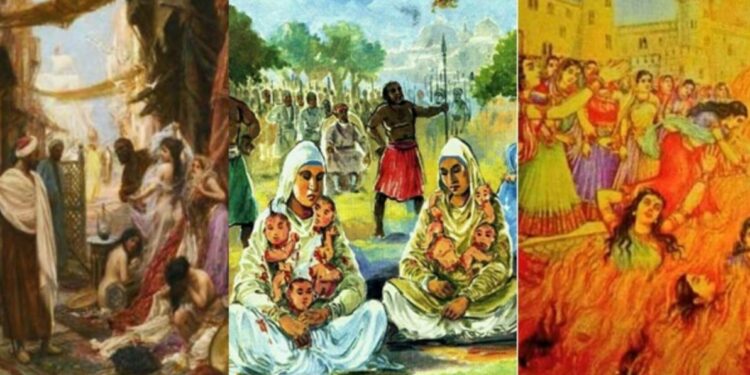Babur, the founder of the Mughal Empire, is known for his military campaigns and conquests in India. However, his reign was also marked by numerous atrocities committed against the people of India. Babur’s conquests were not just military campaigns but were also marked by violence, destruction, and widespread bloodshed.
One of the most well-known atrocities committed by Babur was the massacre of the inhabitants of Delhi in 1526. After his victory over the Delhi Sultanate, Babur ordered his soldiers to loot and pillage the city. According to historical records, the streets of Delhi were filled with corpses, and the city’s population was either killed or enslaved.
Babur also destroyed temples and other religious buildings during his conquests. One of the most significant examples of this was the destruction of the Hindu temple at Ayodhya. The temple was demolished, and a mosque was built in its place. The destruction of the temple led to a long-standing dispute between Hindus and Muslims that has yet to be resolved.
Babur’s atrocities were not limited to religious buildings but also extended to the general population. For instance, Babur ordered the killing of all men in the town of Chanderi after its capture. Women and children were enslaved and distributed among his soldiers as spoils of war.
Babur’s reign was also marked by numerous instances of torture and cruelty. For instance, when he captured the town of Bhera, he ordered that the men be buried alive, and their wives and children be enslaved. In another instance, after capturing the town of Kalinjar, he ordered the execution of all the men and took the women and children as prisoners.
Babur’s reign was also marked by the introduction of new forms of taxation that had a severe impact on the people of India. He imposed the Jizya tax on non-Muslims, which was a discriminatory tax that Muslims did not have to pay. This tax was imposed on Hindus and other non-Muslims, leading to widespread poverty and destitution.
Shocking instances of crime against women
Babur is known for its brutal treatment of women in the areas they conquered. There are numerous accounts of widespread rape, sexual slavery, and forced marriages of women from captured towns and villages. These women were often treated as spoils of war and were subjected to physical and sexual abuse by Babur’s soldiers.
Babur himself is known to have taken many women as his wives, often forcibly. One of his most infamous acts was the abduction of the Rajput princess Rupmati, whom he forcibly married after conquering her kingdom. Babur’s actions in this regard were not limited to India alone – he is known to have taken women as spoils of war during his conquests in Central Asia as well.
There are also accounts of Babur’s army using women as human shields during battles, effectively using them as sacrificial pawns. Women who refused to comply with the orders of Babur’s soldiers were often subjected to brutal torture and execution.
The atrocities committed by Babur and his army have had a lasting impact on the social and cultural fabric of India. The legacy of violence and abuse against women that he helped to establish has continued to plague the country to this day.
It is important to acknowledge the historical context of Babur’s reign and the impact it has had on the lives of countless women in India.
Babur’s reign in India was marked by numerous atrocities committed against the people of India. His conquests were not just military campaigns but were also marked by violence, destruction, and widespread bloodshed. The impact of his actions can still be felt today, and his legacy continues to be a subject of debate and controversy.


















Discussion about this post